Parrot
Parrot Anafi: an ambitious and well-equipped drone
Aprox. 699€ - see price -
See specificationsTo line up in the face of fierce and almost monopolistic competition, Parrot has released the big game with the Anafi. A foldable drone sporting a 4K HDR camera, hybrid stabilization, a battery rechargeable by USB-C and fun functions. The whole presents serious arguments, but will they be enough to convince amateurs essentially turned to DJI? Answer in our test!
Positive points
Foldable and lightweight drone to carry.
Autonomy.
Ease of use.
Image quality in photo and video.
Appreciable zoom function.
Stabilization.
Rechargeable battery in USB-C.
Bad points
Image curvature in Wide mode.
Slightly light finish.
Scope less promising than expected.
No obstacle detection.
Paid tracking function.
No sharing of "live" images.
Our review
Presentation
If some of you think that we have been lenient in delaying the release of the Anafi test, we are wrong: the first copy received at the editor simply did not work, then it is the application which buggy and prevented us from flying safely. Rather than canceling the test, we preferred to postpone its distribution while waiting for a copy in good working order to give you an opinion that we wish to be exhaustive. So here comes the Anafi, a French drone in the featherweight category, armed with its new sensor, a new design and a new application to face the Mavic Air and the Mavic Spark in a modern and fun Grand Cirque.
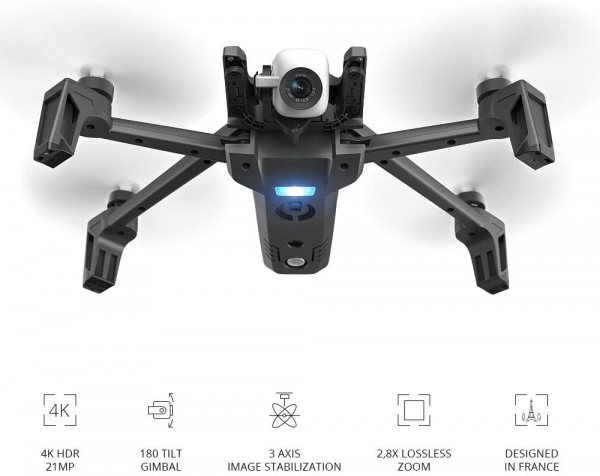
Getting started
Surprising. This is the first qualifier that comes to mind when we discover for the first time the silhouette of the new Parrot drone. Out of its carrying case, the Anafi reveals itself, slender, very thin, almost frail. With its only 67 mm wide and 244 mm long, we cannot say that it plays the big arms. On the contrary, his approach aims to be all in finesse and lightness. A lightness which is confirmed by a weight of only 320 grams but which will not allow the Anafi to pass under the caudine forks of certain regulations. Indeed, if this weight dispenses the remote pilots of the online training, the ambitious or the crazy of the radio control will not be able to fly over Spanish cities either at night. Thus the Anafi is in the same category as the DJI Mavic Air and Dji Spark, with 19 grams more than the latter and 82 grams less than the first.
We wonder at once about the special design of the Anafi which, according to its designers, is directly inspired by the appearance of insects, the head of the wasp and the mandibles of stag beetles. In our opinion, you really have to look for it or squint your eyes on a full moon evening to enjoy it. It is in any case the speech served by Parrot ... and why not after all. Everyone's taste is different. As long as the drone avoids the facies of a crushed octopus or a Fiat Multiplat, we remain open. However, if there is one point on which we will not compromise, it is of course the quality of assembly. And there, we remain a little on our hunger.
After a few weeks of use, we do not regret any breakage or play, but the whole still seems very fragile when faced with the almost perfect finish of a Mavic Air. The latter, more massive, inspires more confidence. Faced with Spark, same observation: the little beast of DJI is better in hand. Another point, all the visible hardware reduces the finish and the seriousness of the construction, even if it is for practical reasons. The Anafi is not a racer and in this price range, again, the competition offers a slightly more upscale visual approach. However, let us emphasize a definite advantage, the drone does not take up space and can be carried very easily in a backpack. Ditto for the radio control supplied in kit, which is also compact (width of 149 mm, height of 72 mm).
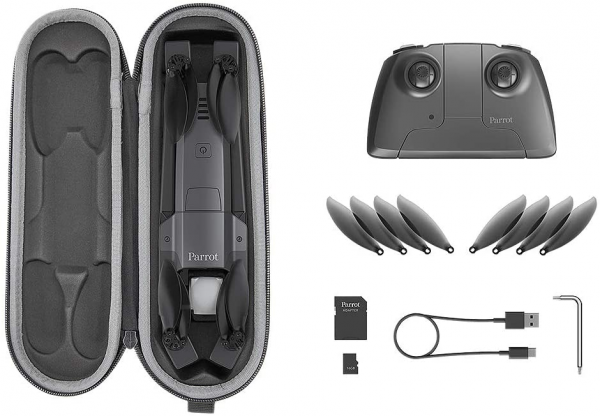
Flight
Armed with its four brushless motors, the Anafi would be able to split the sky up to 55 km / h and to face winds up to 50 km / h. Really ?! Direction the windy lands of the Somme and our unforgiving Val d'Oise. As much to write it right away, our first contacts with Anafi, as written in exergue of this test, were a little chaotic. Unfortunately our first test copy refused to fly, then it was then the Freelight 6 application which presented bugs and blocked while the drone was in the air when we went from photo mode to video mode. A first little reassuring contact which finally ended in a reconciliation once the major update of the application available at the end of August.
To take to the skies, you must first turn on the remote control (by unfolding the Wi-Fi antenna which also serves as a base for the smartphone), turn on the drone, attach the smartphone to the radio control and connect it to the latter via USB cable. The connection allows you to automatically launch the application and enter the flight parameters. The application presents an interesting interface with telemetry indications on the upper part of the screen and shooting indications which are reported on the bottom of the interface. A radar positioned at the bottom right makes it possible to locate the drone in its environment and to see where it is compared to its starting point.
In addition to the classic shooting modes, Freelight 6 allows subject tracking, SmartDronies and CineShots. Automatic flight plans which allow sequences in which the camera and drone are in motion. With the update of the application, we also note the arrival of new bracketing functions, a customizable RTH mode, a burst which goes to 10 frames per second, better exposure control and even a video mode 2, 7K at 30 frames per second. Alert messages are also reinforced. Unfortunately the Anafi is not equipped with obstacle detection.
After selecting the appropriate flight mode, take off by pressing the Take-Off key. The Anafi silently launches its propellers and takes off to stabilize one meter above the ground. Very quickly you get your bearings and the flight is intuitive. By disengaging the speed, the Anafi is even agile, fast and offers some pleasant driving sensations. However, at the writing of dev.rankuzz.com, it is mainly for the shooting that we test the drones. So we calm our heat and we discover the landscape quietly. Video feedback is very good ... as long as the return signal is just as good. Unfortunately, the announced range of 4 km does not keep its promises. Beyond 500 m, the quality of the video return is parasitized and around 1000 m it is complete black or the image freezes. By bringing the drone closer, you recover the signal, but we are far from the promised 4 km range.
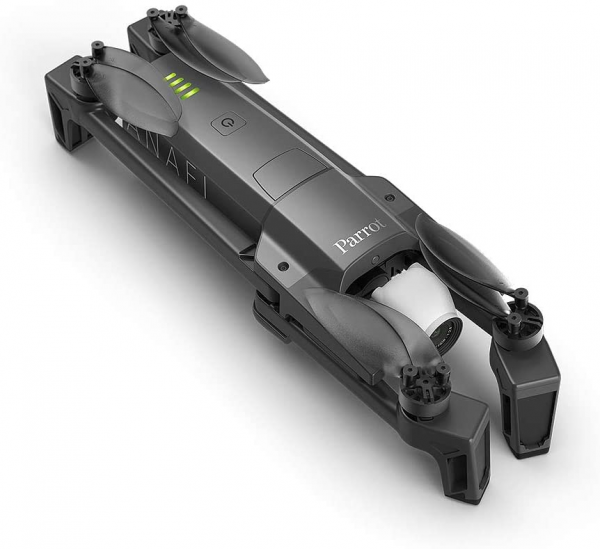
Image quality
We were expecting Anafi on image quality so much in the past our feedback on Bebop 2 and Bebop Power had disappointed us. Parrot seems to have grasped the importance of positioning itself in the aerial photography market and is showing real efforts. An approach that we welcome and which is rewarded with a very interesting image quality.
The 21 Mpx 1 / 2.4 "inch CMOS sensor delivers images with high sharpness, especially in the center, and provides a natural color rendering, without excess of flattery, unlike Mavic Air and especially Spark. Attention, on Raw, we note the presence of noise from the lowest sensitivity, but Parrot preferred not to smooth too much in favor of the details. Here too, we welcome the approach, especially since the Raw DNGs are touched up relatively easily and tolerate even a slight accentuation to recover a little crispness. In Jpeg, watch out for compression artifacts a little too visible on the leaves.
In addition, the Anafi has a digital zoom which allows to achieve a focal length simulation of 69 mm in photo and 78 mm in video. An interesting function which allows above all to create a Vertigo effect by playing with perspectives.
100% 4K video clip
100% 1080p FHD video clip
Recording is done in 4K Cine (4096 x 2160) 24p, 4K UHD (3840 x 2160) 30p, 2.7K 30p and Full HD 1080 60p. The speed increases to 100 MB / s to record a maximum of details and, indeed, it is with pleasure that we discover sequences rich in information and with wide dynamics. The colorimetry is well managed and, above all, the image is full of details. By zooming in, however, we also see some artifacts there. Finally, it is the lens that disappoints us a little in the photo, with a curvature of field too pronounced in Wide mode and a notable sensitivity to flare.
Mechanical stabilization coupled with software stabilization works effectively. Even on slightly abrupt changes of angle, the image does not move. Note also that to share your images directly on the networks, you must first download the files to the smartphone, which is rather long.
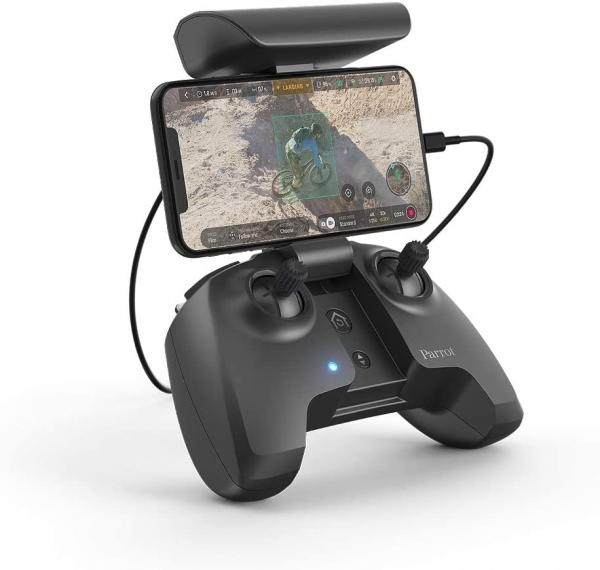
Autonomy
With a 2700 mAh and 7.6 volt Lipo battery, the Anafi promises 25 minutes of flight. Reality is not far off, since we managed to fly 23 minutes with the drone. If the flight conditions are mild, autonomy remains a good level to have fun and perform several sequences. Special mention for the possibility of recharging the battery via USB-C. The charging time with an external battery which delivers 2.1 A takes approximately 2 hours. Allow 2h30 to recharge the Skycontroller 3. As usual, we can only recommend that you equip yourself with a second battery to take full advantage of the different functions and not find yourself deprived when the autonomy is over.
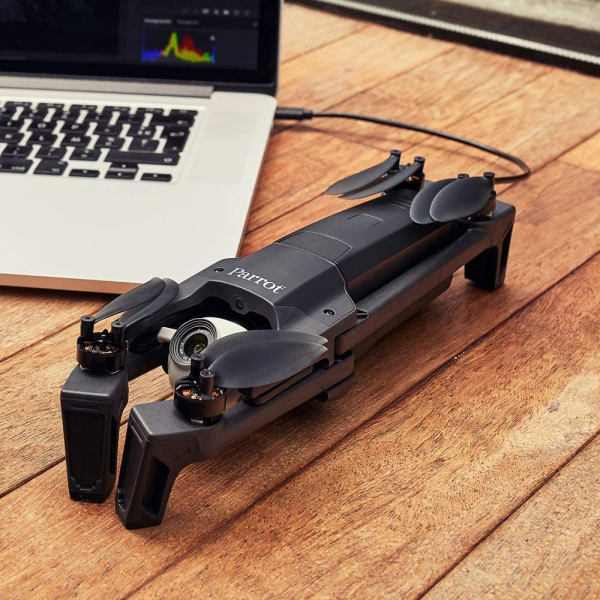
Conclusion
Undeniably, the Parrot Anafi arrives armed to gain a place in a market trusted by DJI. And certainly, we enjoyed flying with it - except for the initial bugs, which have now been fixed - thanks to its agility and its playful interface. Its image quality immediately places it in drones intended for shooting and its rechargeable battery in USB is a plus. It remains to be seen whether these arguments will be enough to convince users, knowing that the DJI Mavic Air, barely more expensive, keeps for it a better finish, a better connection and offers some additional functions. The Anafi is a good drone, but it still lacks a bit of maturity.
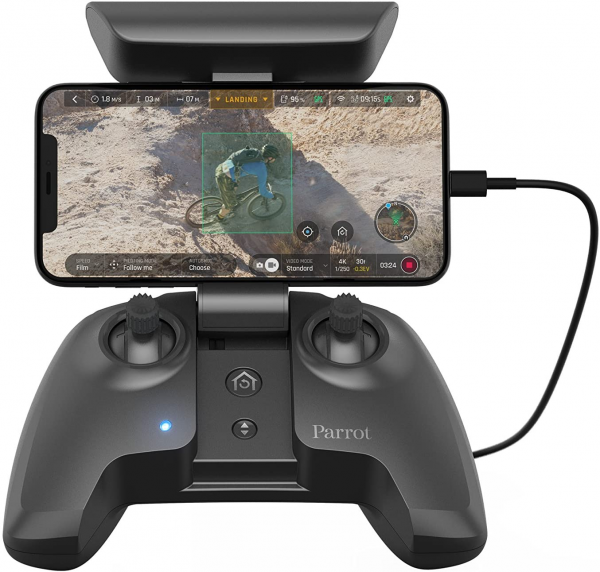
Specifications
Reviews

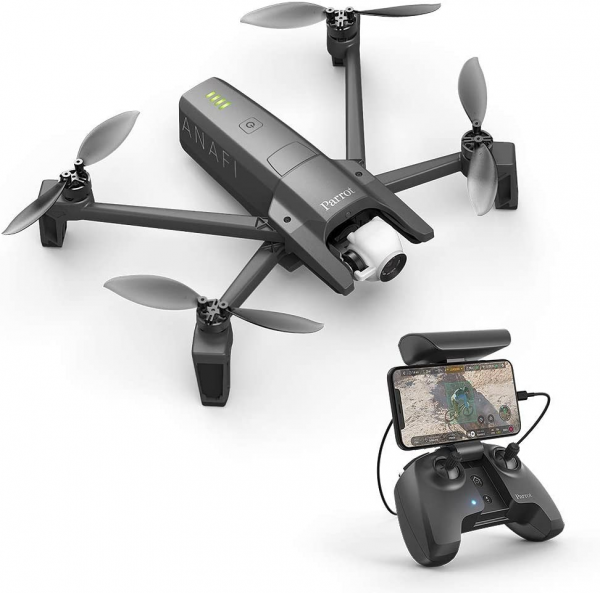
Finally a drone which can compete with the DJI Mavic.
This is a fantastic little drone. It is light and extremely portable. It has a great camera with an outstanding 3x zoom. It has a true 25 minute flight time. It has a half-dozen special flight modes as well as the essential GPS position hold and smart RTH. This is the first drone on the market that can honestly compete with the DJI Mavic. Today I flew both the Anafi and the Mavic for several hours. The Mavic has twice the flight range, but the Anafi is competitive or better in just about every other aspect. Overall, I prefer the Anafi as my "travel drone" now.
(I am an FAA licensed drone pilot with six years of experience flying many different drones including the DJI Phantom series, Mavic, and Spark as well as Yuneec, Cheerson, Holy Stone, and Hubsan drones.)
Need to wait for 15 days before unlocking "follow me"...
The Anafi is an incredible piece of technology, with stunning pictures and video. It is lightweight and compact, and very portable.
The hardware people did an outstanding job in developing this drone. Where they fall short is on the execution / app side. Having to pay an extra $ 19.90 to unlock "follow me" is just petty. Why not include this awesome feature in the price, since most people are going to use it. When I tried to click on "Buy" in the app, nothing happened. I rebooted my iphone, still not possible to buy "follow me". Uninstalled and reinstalled Freeflight, still no go. I finally contacted Tech Support, who got back to me within hours (good customer service!). Here is what they said:
"Kindly note that in order to purchase the follow me application you need to have completed the trial version first for 15 days, After completion of the 15 days you will be able to proceed and purchase the application with the normal steps."
That just blows my mind! I have to wait for 15 days before I can buy the coolest features on the drone? Seriously people? Why? And if you want to slap users with such an onerous policy, how about telling them about this policy, either in the app, or on the website?
Bad quality control
Thing this over Mavic because of USB-C charging and 180 degree camera. Apparently there is zero quality control on these things.
The first one I received, I was pretty excited about it ... Until I realized that one of the feet was damaged (see photos) Mind you, I never flew the thing. Literally only took it out of the case. So, whatever. Amazon has great customer service, I'll just get a replacement.
Second one arrived two minutes ago. Opened the case and .... the same damage in the same spot. Sure, it's only the plastic not fitting together properly, but it's not like this is as cheap as the Parrot Minidrones. More importantly if you can't get the plastic right how in the world can I trust the drone itself (considering it's massively more complicated.)
Really disappointed at this point.
Great image even when you zoom in, flight time above the competition and so quick to unfold and fly
I only got the drone a couple days ago so this is a first review right as I landed my third flight.
To start with, with the Anafi, Parrot brings THREE NEW FEATURES on the drone market AT THIS PRICE POINT.
First, the image: the Anafi captures a crisp 4K HDR which is great to work with in post. Just AirDroped some videos of a crowd from my MacBook Air to my iPhone ... the level of details is amazing even if you pinch and zoom with your mobile.
The other new spec is the upward tilt of the gimbal (180 °), this is a totally new perspective and I can't wait to see what creative shots Anafi users will make out of this feature. My own creativity is puzzled.
Lastly this drone offers in-camera zoom capabilities: FINALLY! This is especially great to create a vertigo effect directly from your drone as opposed to creating it in post.
As for the gimbal, even in sports mode, it creates stable footage. I was worried about the 3 axis gimbal (one digital stabilization and three mechanical) but it seems to be working very well, even if I still want to explore that feature. But I read many times that the digital stab was better on the long run as it can't break as a mechanical ones ...
As far as the battery goes, I flew for 19min and landed with 17% battery left so we are right in that sweet spot: about 25min per battery. Finally, the drone itself is compact and quick to fold, I'd say less than a minute to operate and coming from a Phantom 3, not having to screw the props on is a big time saver.
Then, on my test-runs the wind was not strong so I couldn't test the 50km / h wind resistance (for comparison, the mavic air is about 40km / h). Maybe I'll write some other post to let you know. Until then, WELL DONE ANAFI!